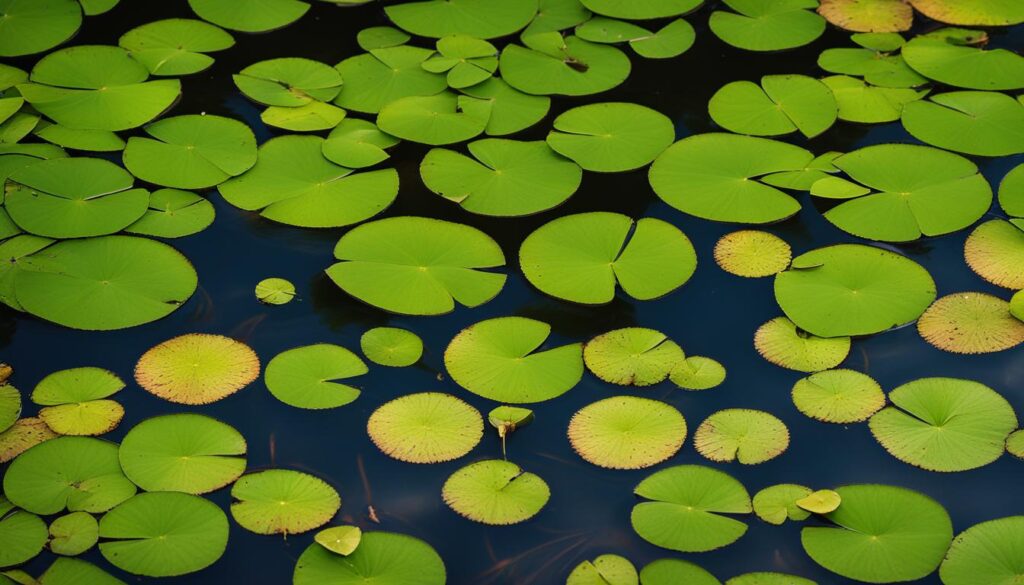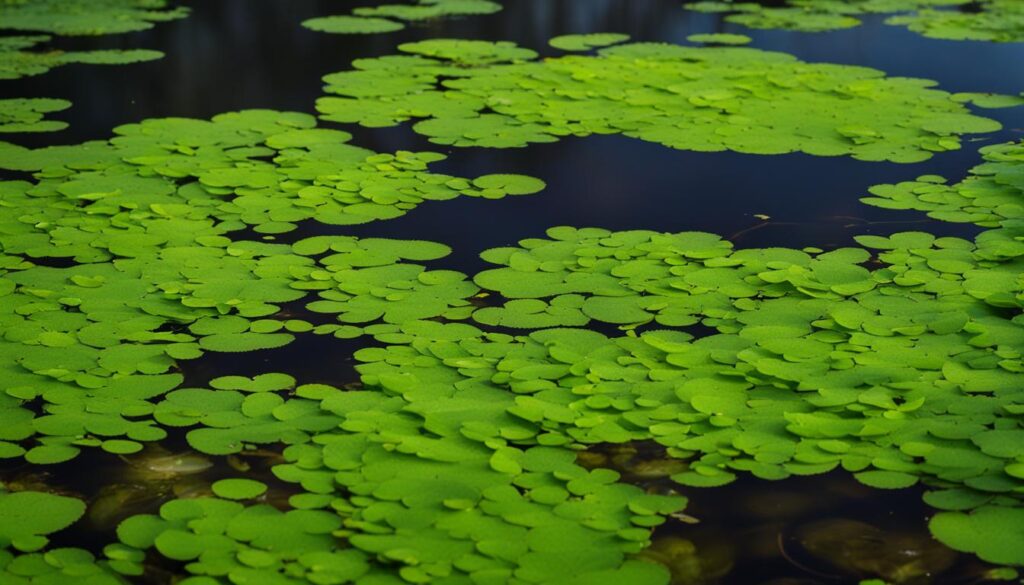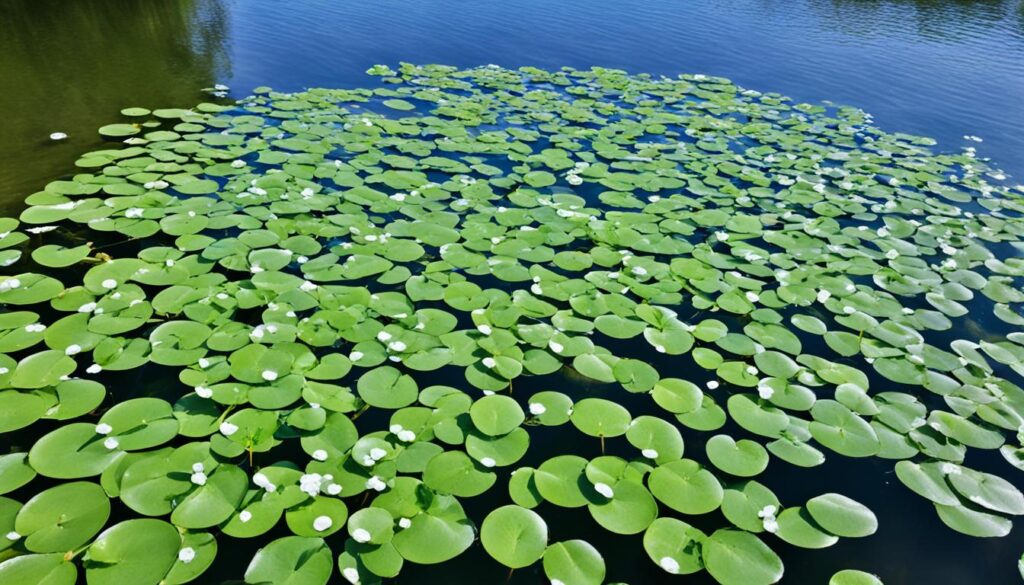Welcome to the Small Duckweed Florida Aquatic Plant Guide. This section will provide a comprehensive overview of the Small Duckweed Florida Aquatic Plant. You will learn about its unique characteristics, habitat, and distribution in Florida and its significance in the state’s freshwater ecosystems.
Angler’s Essentials:
- The Small Duckweed Florida Aquatic Plant is a species that thrives in Florida’s freshwater ecosystems.
- It is a small-sized plant that floats on the surface of the water.
- Small Duckweed is commonly found in lakes, rivers, and ponds across Florida.
- This plant plays a crucial role in nutrient cycling, water purification, and providing habitat for aquatic organisms.
- By understanding the Small Duckweed Florida Aquatic Plant, we can appreciate its contribution to the health and balance of Florida’s aquatic environments.
Introduction to the Small Duckweed Florida Aquatic Plant
Get ready to dive into the fascinating world of the Small Duckweed, a Florida Aquatic Plant. As its name suggests, this species is commonly found in Florida’s aquatic environments. Duckweed is common. Let’s explore the unique characteristics that make this plant so intriguing.
The Small Duckweed, also known as Lemna minor, is a tiny floating plant that belongs to the Lemnaceae family. It is one of the world’s most miniature flowering plants, each measuring only a few millimeters in size. Despite its tiny stature, it plays a significant role in the ecosystem of Florida’s freshwater bodies.
“The Small Duckweed Florida Aquatic Plant is a vital component of the freshwater ecosystem, providing numerous benefits to the environment and its inhabitants.”
One of the remarkable characteristics of the Small Duckweed is its ability to float on the water’s surface. This allows it to receive optimal sunlight for photosynthesis while efficiently utilizing its limited resources. Its small size also enables it to reproduce rapidly, forming dense mats over the water’s surface.
The Small Duckweed is commonly found in still or slow-moving bodies of water, such as ponds, lakes, and marshes. Its prevalence in Florida’s aquatic environments can be attributed to the state’s warm climate and ample sunshine, which provide ideal conditions for its growth.
Aside from being a visually appealing feature of Florida’s water bodies, the Small Duckweed plays a crucial ecological role. It forms a floating green carpet on the water, providing shade and shelter for various aquatic organisms. Additionally, it serves as a valuable food source for waterfowl, insects, and other herbivorous animals, contributing to the overall food chain.
Key Features of the Small Duckweed Florida Aquatic Plant:
- Small size, measuring just a few millimeters
- Floats on the surface of freshwater bodies
- Rapid growth and reproduction
- Prevalent in Florida’s warm aquatic environments
- Provides shade and shelter for aquatic organisms
- Important food source for waterfowl and insects
| Appearance | Reproduction | Habitat |
|---|---|---|
| The Small Duckweed has small, oval-shaped leaves that float on the water’s surface. These leaves are bright green, providing an eye-catching display across Florida’s water bodies. | The plant reproduces through a process called vegetative propagation. Each plant forms buds, which then detach and grow into independent individuals. This rapid reproduction allows the Small Duckweed to cover vast areas in a short period. | The Small Duckweed is adapted to various freshwater habitats, including lakes, rivers, and ponds. It can thrive in both stagnant and slow-flowing water, taking advantage of the available sunlight and nutrients. |
Keep exploring this comprehensive guide to learn more about the habitat, distribution, benefits, and significance of the Small Duckweed Florida Aquatic Plant.
Habitat and Distribution of Small Duckweed
When exploring the fascinating world of the Small Duckweed Florida Aquatic Plant, it is essential to understand its habitat and distribution patterns. This remarkable plant thrives in various freshwater ecosystems throughout Florida, including lakes, rivers, and ponds. Let’s dive deeper into the specific habitats where this aquatic plant can be found.
Lakes
Lakes offer a suitable habitat for the Small Duckweed Florida Aquatic Plant due to their stillness and nutrient-rich waters. This plant can float on the lake’s surface, maximizing its exposure to sunlight for photosynthesis. Its tiny size allows it to form dense mats that cover large areas, providing vital shade and protection for other aquatic organisms.
Rivers
With their flowing currents, rivers are another ideal habitat for the Small Duckweed. This plant can adapt to the varying water flow and anchor itself to rocks or other structures along the riverbed. The small Duckweed’s ability to colonize rapidly helps stabilize riverbanks and prevent erosion while providing a valuable food source for fish and waterfowl.
Ponds
Ponds, both natural and man-made, are often teeming with Small Duckweed. These confined water bodies offer an abundance of nutrients and sunlight, allowing this plant to thrive. Due to its rapid growth, Small Duckweed can quickly cover the surface of ponds, providing shelter for tiny organisms and contributing to the ecosystem’s overall health.
Several factors contribute to the spread and distribution of the Small Duckweed Florida Aquatic Plant across the state. Its small size and ability to reproduce rapidly allow it to colonize new areas and establish dense populations. The warm climate of Florida also provides optimal conditions for its growth and survival throughout the year.

In summary, the Small Duckweed Florida Aquatic Plant is a versatile species that can adapt to various freshwater habitats such as lakes, rivers, and ponds. Its ability to thrive in different environments contributes to its widespread distribution across Florida. Understanding this plant’s habitat preferences and distribution patterns is crucial for comprehending its ecological significance and overall impact on Florida’s aquatic ecosystems.
Benefits and Significance of Small Duckweed
You can look at the benefits and significance of the Small Duckweed Florida Aquatic Plant. This small, floating plant plays a vital role in the balance and health of Florida’s freshwater ecosystems.
Nutrient Cycling
Small Duckweed is an efficient nutrient-cycling agent. It absorbs excess nitrogen and phosphorus from the water, helping to prevent eutrophication and the formation of harmful algal blooms. This promotes clearer water and a healthier aquatic environment for plants and animals.
Water Purification
This remarkable aquatic plant also contributes to water purification. Through its vigorous growth, it filters contaminants, sediments, and pollutants, improving water quality and creating a more sustainable ecosystem. Small Duckweed acts as a natural water treatment solution, enhancing the overall health of Florida’s freshwater habitats.
Habitat Provision
Small Duckweed provides essential habitat for a variety of aquatic organisms. Its dense mats create shelter and breeding grounds for small fish, insects, and amphibians. These floating mats offer protection and support for organisms at various stages of their life cycles, enhancing biodiversity and contributing to the intricate web of life in Florida’s aquatic ecosystems.
“Small Duckweed serves as a critical part of the freshwater food chain, offering a valuable food source for herbivorous fish, ducks, and other waterfowl.”
Furthermore, it also acts as a nursery for young fish, providing them with a safe hiding place from predators. The presence of Small Duckweed in aquatic habitats enhances the overall ecological balance and ensures the survival of species that rely on it for food and shelter.
To visualize the importance of Small Duckweed, take a look at the diagram below:

| Benefits of Small Duckweed | Significance |
|---|---|
| Nutrient Cycling | Prevents eutrophication and algal blooms |
| Water Purification | Filters contaminants and pollutants |
| Habitat Provision | Creates shelter and breeding grounds |
As shown in the diagram and table above, Small Duckweed is crucial in maintaining the ecological balance and health of Florida’s aquatic environments. Its ability to cycle nutrients, purify water, and provide habitat demonstrates its significance in supporting a diverse and thriving ecosystem.
Conclusion
In conclusion, the Small Duckweed Florida Aquatic Plant is important in Florida’s freshwater ecosystems. Its small size and floating nature make it a unique plant that serves various ecological functions. Small Duckweed, commonly found in Florida, contributes to nutrient cycling and water purification and provides habitat for aquatic organisms. By understanding its characteristics, habitat, and benefits, we can appreciate its role in maintaining the health and balance of Florida’s aquatic environments.
Whether it provides shade and shelter for fish, removes excess nutrients from the water, or serves as a food source for animals, the Small Duckweed Florida Aquatic Plant plays a crucial role in the intricate web of life in Florida’s waterways. Its ability to multiply rapidly and cover the water’s surface has advantages and disadvantages. While it provides important ecological services, it can also create challenges for recreational activities on lakes and ponds.
As we continue to study and monitor the Small Duckweed Florida Aquatic Plant, it’s important to balance its ecological significance with the needs of humans who utilize and enjoy Florida’s freshwater environments. By employing sustainable management practices, we can ensure the coexistence of this unique plant with other species and maintain the overall health of Florida’s aquatic ecosystems for future generations.
FAQ
What is Small Duckweed Florida Aquatic Plant?
Small Duckweed Florida Aquatic Plant is a small-sized floating plant species commonly found in freshwater ecosystems in Florida. It is also known as Duckweed Florida or simply Small Duckweed.
Where is Small Duckweed commonly found in Florida?
Small Duckweed is commonly found in various types of freshwater habitats in Florida, including lakes, rivers, ponds, and marshes.
What are the unique characteristics of Small Duckweed?
Small Duckweed is characterized by its tiny size and floating nature. It consists of small, oval-shaped leaves and often forms dense mats on the water surface.
How does Small Duckweed contribute to the ecosystem?
Small Duckweed plays a significant role in Florida’s freshwater ecosystems. It helps in nutrient cycling, acts as a natural water purifier, and provides shelter and food for various aquatic organisms.
Does Small Duckweed have any benefits?
Yes, Small Duckweed has several benefits. It helps in reducing excess nutrients in the water, thus preventing algal blooms. It also contributes to the overall health and balance of the aquatic environment.
Can I grow Small Duckweed in my own aquatic setup?
Yes, Small Duckweed can be cultivated in small-scale aquatic setups such as ponds or fish tanks. However, ensure proper maintenance and management to prevent excessive growth and spread.
Is Small Duckweed harmful to other aquatic plants?
Small Duckweed can compete with other aquatic plants for resources, sunlight, and nutrients. In some cases, it may outcompete and suppress the growth of other plant species.
How can I control the growth of Small Duckweed in my pond or lake?
Controlling the growth of Small Duckweed can be challenging. Physical removal, manual skimming, and the use of appropriate herbicides or biological control methods can help manage its growth effectively.
Is Small Duckweed edible for humans or animals?
Yes, Small Duckweed is edible and can be consumed by certain animals, including ducks, fish, and turtles. It is also used as a food source in some cultures.
Does Small Duckweed have any medicinal properties?
While Small Duckweed is not commonly used for medicinal purposes, it is known to contain some nutrients and antioxidants that may have potential health benefits.
